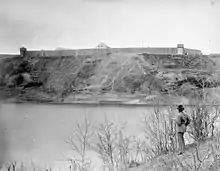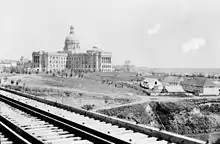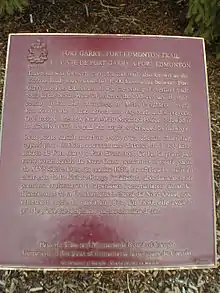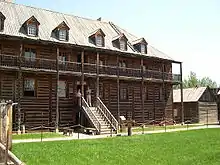Fort Edmonton
Fort Edmonton (also named Edmonton House) was the name of a series of trading posts of the Hudson's Bay Company (HBC) from 1795 to 1891, all of which were located in central Alberta, Canada. From 1795 to 1821 it was paired with the North West Company's Fort Augustus. It was the end point of the Carlton Trail, the main overland route for Metis freighters between the Red River Colony and the west and an important stop on the York Factory Express route between London, via Hudson Bay, and Fort Vancouver in the Columbia District.
The fifth and final Fort Edmonton was the one that evolved into present-day Edmonton.
Fort Edmonton was also called Fort-des-Prairies, by French-Canadians trappers and coureurs des bois, and Amiskwaskahegan or "Beaver Hills House" by the Cree, the most populous Indigenous peoples in the region during the 19th century.[1][2]
First Fort Edmonton (1794–1802)
Coordinates: 53°46′5″N 113°10′19″W
In the late 18th century, the Hudson's Bay Company was in fierce competition with the North West Company for the trade of animal furs in Rupert's Land. As one company established a fur trading post, the other would counter by building another post in close proximity. Expansion up the Saskatchewan River began in the 1790s. In the summer of 1795, the North West Company constructed Fort Augustus where the Sturgeon River meets the North Saskatchewan River, just north of the present-day city of Fort Saskatchewan, approximately 35 kilometres (22 mi) northeast of the final Fort Edmonton (near the present-day Alberta Legislature Building in Edmonton). In the following autumn, Hudson's Bay constructed Edmonton House closeby, taking advantage of the same two rivers; in a possible revelation of the competitive nature of the companies, Fort Augustus and Edmonton House's distance was described as being a "musket-shot" apart,[3] yet the proximity also offered mutual security to the European traders of both companies in a land where they were all intruders.[4]
Edmonton House, and the subsequent forts, was named by John Peter Pruden, clerk to the HBC's George Sutherland. The Fort was named after Edmonton, Middlesex, England, birthplace of both Pruden and HBC Deputy Governor Sir James Winter Lake.[5]
Second Fort Edmonton (1802-1810)
Coordinates: 53°31′44″N 113°29′53″W
In 1802, due to several years of declining fur returns and increasingly scarce firewood, it was decided to move Fort Edmonton and Fort Augustus upstream, to what is now the Rossdale area of downtown Edmonton. This area had been a gathering place for aboriginals in the region for thousands of years.[3]
The first woman of European descent to live in this region was the French-Canadian Marie-Anne Lagimodière (née Gaboury), who was also noteworthy as the grandmother of Louis Riel. She had accompanied her fur trader husband, Jean-Baptiste Lagimodière, into the west shortly after their marriage in Trois-Rivières, Québec, and was known to take part in hunting expeditions. The couple lived in Fort Augustus from 1807 to 1811.
John Rowand, the Chief Factor at Fort Edmonton from 1823 to 1854, first worked at Fort Augustus from 1804 to 1806; he was stationed there again from 1808 onward.[6]
Evidence of this Fort Edmonton was found in 2012, when crews were excavating under a demolished machine shop at the Rossdale Power Plant.[7]
Third Fort Edmonton (1810–1812)
Coordinates: 54°3′40.88243″N 112°16′11.9″W [8]
Both Fort Augustus and Fort Edmonton moved to the mouth of White Earth Creek, 100 km northeast of modern Edmonton at the northernmost point of the North Saskatchewan near present-day Smoky Lake, Alberta. The place is also known as Fort White Earth, or Terre Blanche.[9]
This location was only active for two years for two main reasons: the Cree had been encouraged to visit other posts to avoid violent confrontations with the Blackfoot, yet the generally more southerly Blackfoot refused to travel so far off of their normal circles and consequently took their trade south to Americans. [10]
While the Hudson's Bay Company and North West Company still operated separate posts, in direct competition with each other, the two posts were built inside a shared palisade.
After its abandonment in 1812, the forts fell into ruin and little remains of them. There is no official signage on the site. Perhaps a local name for a creek that enters the Saskatchewan on the south side of the river opposite the site commemorates the old forts - its name is Fort Creek.
Fourth Fort Edmonton (1813–1830)
Coordinates: 53°31′44″N 113°29′53″W
Fort Edmonton and Fort Augustus moved back to the second site at the Rossdale flats, it having proven to be a site more amenable for the tribes to visit.
The name Fort Augustus was dropped following the forced merger of the Hudson's Bay Company and the North West Company in 1821. After the amalgamation of the companies (which thereafter used the Hudson's Bay Company name), Fort Edmonton became the headquarters for the Saskatchewan District of Rupert's Land, which stretched from the Canadian Rocky Mountains in the west to Fort Carlton in the east; from the 49th parallel in the south to Lesser Slave Lake in the north. The former Nor' Wester John Rowand was placed in charge of Edmonton in 1821 as chief trader. In 1823, Rowand was promoted to chief factor. Rowand managed Saskatchewan District from Fort Edmonton until his death in 1854.
Fifth Fort Edmonton (1830–1915)
Coordinates: 53°31′55″N 113°30′24″W
Due to floods in the late 1820s, the Fort on the Rossdale flats had to be moved to higher ground in 1830.[3] This fifth and final fort stood for 85 years, though its use as a fur trading post was phased out starting in 1891; during its final years, the Fort co-existed with the Alberta Legislature Building, which opened in 1913 on a rise just north of the fort.[11]

Rowand's administration
At this time, a long-serving member of the HBC, John Edward Harriott, became the chief trader under Rowand. The two gained family ties when Harriott married one of Rowand's daughters. On a couple of occasions when Rowand joined HBC Inland Governor George Simpson for travel abroad, Harriott acted as chief factor.
Rowand's administration from the 1830s onward coincided with a great change in the Saskatchewan District. For the first time, missionaries, artists, and curious travellers came to Edmonton to visit, sometimes for extended periods, which frustrated Rowand to some degree. Prior to this time, the only Europeans to come that far into the west were men on some sort of company business.
With Rowand having made Edmonton his home, the fort became an important centre in the west. It was a necessity for any traveller going any further west of Edmonton to go through there for provisions first. Rowand constructed a three-storey house in the heart of the fort for the exclusive use of him and his family, denoting his station to his subordinates, visitors and trade partners alike.
Influx of missionaries
Two Catholic missionaries, Francois-Norbert Blanchet and Modeste Demers, were the first to visit Fort Edmonton (called Fort-des-Prairies) in 1838.[12] Starting in 1840, the Fort housed the Wesleyan missionary Robert Rundle as a company chaplain. Rundle's tenure lasted until 1848, and his ministry and missionary work was met with competition of a sort by Jean-Baptiste Thibault, a Catholic priest who, like Rundle, was attempting to evangelize natives in the area. A chapel was erected inside the fort in 1843, which the Reverend Rundle boasted could host "(one) hundred Indians"; the structure also had two small rooms for Rundle's private use.[13] Meanwhile, Rowand complained that the presence of ministers in his fort was a distraction for the natives, and was ostensibly impeding the fur trade business.[14] On a personal level, however, Rowand had taken a liking to Rundle, and entrusted the minister with teaching his children.[15]
Father Pierre-Jean De Smet spent the winter of 1845-46 at Fort Edmonton having traveled and explored from Oregon Country to meet the natives of the Rocky Mountains.
In 1852, the Oblate missionary Albert Lacombe first visited Fort Edmonton. With Rundle having trouble controlling the department in 1848, Lacombe easily took up residence in the former Methodist chapel. Lacombe took pity on the fur trade labourers, opining that, "during the summer months, [Hudson's Bay labourers' toil] was as hard as that of the African slave.".[16] He found little sympathy for the workers from John Rowand or the HBC clerks. The following year, Lacombe moved to Lac St. Anne, but had a new Catholic chapel constructed in the fort in 1857 (but did not dwell there); this chapel lasted nearly twenty years before being moved outside of the fort.
A Methodist follow-up to Robert Rundle, Reverend Thomas Woolsey, was dispatched to Edmonton in 1852. His arrival in the fort coincided with Lacombe's residency in the former Methodist chapel, a discovery which distressed Woolsey. Conflicts and private frustrations with Catholic missionaries, and failures to convert Catholics to Protestantism, marked Woolsey's twelve-year residence at the fort.
In 1854, the mission St. Joachim was officially founded in turn at Fort-des-Praires (Fort Edmonton).
Oregon mission

Though somewhat distant from the territory in question, Fort Edmonton, an important stop on the York Factory Express overland trade route, was peripherally involved in the Oregon Boundary Dispute. A pair of British Army lieutenants, Mervin Vavasour and Henry James Warre, were sent on a mission in the guise of eccentric gentlemen to reconnoitre the lower Columbia River valley and Puget Sound. Among other objectives, they were to determine which HBC posts could be used in a military conflict.[17][18] The trip had been encouraged by Sir George Simpson Governor of the Hudson's Bay Company. Warre and Vavasour reported that the mountain passes were unsuitable for troop transport. Their mission took them through Fort Edmonton in the fall of 1845, and again on their way back to Montreal in 1846. They wrote: "Without attempting to describe the numerous Defiles through which we passed, or the difficulty of forcing a passage through the burnt Forests, and over the high land, we may venture to assert, that Sir George Simpson's idea of transporting troops. . . with their stores, etc. through such an extent of uncultivated Country and over such impracticable Mountains would appear to Us quite unfeasible." As with other forts he visited on this mission, Vavasour drew a plan of Edmonton.
Other notable visitors

The artist Paul Kane first visited the fort in 1845. He produced several works of art based upon his time there.
Rowand's end
In May 1854, John Rowand died while accompanying the annual York Boat trip eastward. Accounts suggest that he tried to break up (or join) a skirmish between some of the tripmen while at Fort Pitt, and in his rage he fell suddenly dead. He was initially buried at Fort Pitt, but was later exhumed and buried in Montreal as per his last will and testament.[19]
Remaining administrators
Following a few short-lived administrations in Rowand's wake, William J. Christie was a long-lasting chief factor at Edmonton from 1858 to 1872. Christie's protégé Richard Charles Hardisty, later a Canadian Senator, served as chief factor in Edmonton for an interim period from 1862 through 1864.
The Hudson's Bay Company relinquished Rupert's Land to the Government of Canada in 1868, pursuant to the Rupert's Land Act 1868, thus ending the HBC's administration of the vast territory and beginning an era of settlement in the 1870s.
By the 1890s, the fort was in disrepair and largely abandoned. The Hudson's Bay Company transitioned to retail stores, and business in Edmonton ran from one of those instead.
Explorers
In 1841 James Sinclair stopped at Fort Edmonton to receive instructions on where to cross the Rockies. With him were about 116[20] to 121[21] mostly Métis settlers from the Red River Colony, hired by the Pugets Sound Agricultural Company to settle on Fort Nisqually and Cowlitz Farm within modern Washington state.
Captain John Palliser stayed in Fort Edmonton for a time in 1858 while on his famous expedition. With the help of the factor's wife, Palliser held a ball there.[22]
In 1859, the 9th Earl of Southesk visited on his way to the Rocky Mountains, hoping that the fresh mountain air would improve his health.[23]
Under threat of warfare

The spring of 1870 saw Fort Edmonton come under the threat of violence due to a war between the Blackfoot and Cree, resulting from the slaying of Cree Chief Maskipiton. A group of the Blackfoot approaching the fort from the south caught some traders with wagons of goods on the south bank. The traders escaped by ferry but had to leave their wagons behind. The ferry was not sent to the Blackfoot and were not able to give chase as they were unable to ford the North Saskatchewan due to high spring waters. They encamped in today's Walterdale neighbourhood of Edmonton, plundered the wagons and harassed the fort with their muskets. The men in the fort armed themselves and prepared to fight. But the fort was not attacked in force. The Chief Factor William J. Christie ordered the Bay men not to go out to attack the Blackfoot, apprehensive that to do so would invite further violence against the Hudson's Bay Company.[24]
Fifteen years later, on March 19, 1885, during the North West Rebellion, Edmonton's telegraph wire was cut. Fearing imminent attack, many local settlers and their families took shelter behind the fort's old wooden palisade. No attack happened. Within a few weeks marching and mounted troops arrived from southern Alberta and from eastern Canada by way of the CPR station at Calgary, to ensure that no local outbreak would occur.[25]
Dismantling
What remained of the fifth Fort Edmonton was dismantled in 1915. It was seen as a crumbling eyesore next to the Alberta Legislature Building, which had been completed three years earlier.[26] The Government of Alberta indicated at the time that it would use the old fort's timbers to create a heritage site elsewhere in the city, but it never did.
List of chief factors
| Chief Factors at Fort Edmonton | ||
|---|---|---|
| Chief Factor | Years Served | Notes |
| William Tomison | 1795–1796 | Started Edmonton House to compete with NWC Fort Augustus. |
| George Sutherland | 1796–1797 | |
| William Tomison | 1797–1798 | |
| James Curtis Bird | 1799–1816 | The fort was relocated twice during Bird's tenure. |
| Hugh Carswell | 1816–1817 | |
| Francis Heron | 1817–1821 | HBC and NWC merger coincides with the end of Heron's tenure; afterward, Fort Augustus was absorbed into Fort Edmonton. |
| James Sutherland | 1821–1822 | |
| John Rowand | 1823–1840 | Longest-serving chief factor at Edmonton. |
| John Edward Harriott | 1841–1842 | Rowand's chief trader and son-in-law by country marriage. |
| John Rowand | 1842–1846 | |
| John Edward Harriott | 1847–1848 | |
| John Rowand | 1848–1854 | Final years of service; died May 30, 1854. |
| William Sinclair | 1854–1857 | |
| John Swanston | 1857–1858 | |
| William J. Christie | 1858–1872 | |
| Richard Charles Hardisty | 1872–1883 | Later a Canadian Senator. |
| James MacDougall | 1883–1885 | |
| Richard Charles Hardisty | 1885–1888 | |
| Harrison S. Young | 1888–1891 | |
| William T. Livock | 1891–1910 | Transitioned to the retail store located on Jasper Avenue in what is now Edmonton's downtown core. The outward face of an old HBC department store still exists there, but the building is presently inhabited by a branch of the U of A and the Edmonton Public Library. It is currently known as Enterprise Square. |
Legacy

In 1923 the suspected site of the original Forts Augustus and Edmonton at Fort Saskatchewan was declared a National Historic Site of Canada, and a plaque was placed on the site.
In 1959, the site of the fourth Fort Edmonton (Fort Edmonton III) was also made a National Historic Site and plaque was installed near the Alberta Legislature building.
Similarly the Fort Edmonton-Fort Gary Trail was also named a National Historic Site and a plaque for it was installed in Edmonton in 1996.

Fort Edmonton Park
In 1969, a reconstruction of the fifth Fort Edmonton began five kilometres upstream from its final site, representing it as it stood in 1846, but this time on the south bank of the North Saskatchewan River. This marked the beginning of Fort Edmonton Park, which has become one of the city's premier tourist attractions. The park represents, through various historical buildings, four distinct time periods, exploring Edmonton's development from a fur trade post in the vast Northwest, to a booming metropolitan centre after the First World War.
See also
Citations
- Fort-des-Prairies
- Naming Edmonton: from Ada to Zoie, (ed.) Merrily K. Aubrey, University of Alberta Press, Edmonton (Alta.), 2004, Edmonton Historical Board, Heritage Sites Committee. p. 18
- Fort Edmonton
- Goyette & Roemmich 2005, p. 25.
- Frederick William Howay: Builders of the West (Ryerson, 1929)
- INDIAN TERRITORIES (ALBERTA) 1800–1829
- Collinson, Laura (2012-08-09). "Evidence of early fur trade post found under old power plant". CTV News Edmonton. Retrieved 2019-09-10.
- Scmid, Horst (1976). Ministerial Order OC 676/76. Edmonton: Lieutenant Governor in Council. p. 5.
- "Fort White Earth, Alberta Heritage Resources Management Information System (HeRMIS)". Retrieved October 31, 2019.
- Coues, Elliott (1897). The Manuscript Journals of Alexander Henry and David Thompson 1799-1814. New York: Francis P. Harper. pp. 451, 563, 584–586, 595, 632–633.
- Canadian Parliamentary Review – Article
- Goyette & Roemmich 2005, p. 30.
- Rundle 1977, pp. 143-144.
- Goyette & Roemmich 2005, p. 56.
- Rundle 1977, p. xliii.
- Goyette & Roemmich 2005, p. 59.
- ABCBookWorld Archived May 26, 2011, at the Wayback Machine
- Cover Story – Warre's War Archived February 2, 2014, at the Wayback Machine
- Goyette & Roemmich 2005, pp. 68-69.
- Galbraith 1954, p. 254.
- Simpson 1847, p. 62.
- John Palliser and Henry Hind – The Arctic and More – 19th Century – Pathfinders and Passageways
- Alberta museum lands bulk of rare aboriginal collection
- Goyette & Roemmich 2005, pp. 109-112.
- Goyette & Roemmich 2005, p. 143.
- Real Estate Weekly
Bibliography
- Goyette, Linda; Roemmich, Carolina Jakeway (2004), Edmonton: In Our Own Words, Edmonton, AB: University of Alberta Press, ISBN 0-88864-449-3
- Galbraith, John S. (1954), "The Early History of the Puget's Sound Agricultural Company, 1838-43", Oregon Historical Quarterly, Oregon Historical Society, 55 (3): 234–259
- Rundle, Robert (1977), Hutchinson, Gerald; Dempsey, Hugh Aylmer (eds.), The Rundle Journals, 1840-1848, Calgary: Alberta Records Publications Board
- Silversides, Brock (2005), Fort de Prairies: The Story of Fort Edmonton, Surrey, BC: Heritage House Publishing, ISBN 1-894384-98-9
- Simpson, George (1847), An Overland Journey Round the World, during the Years 1841 and 1842., Philadelphia: Lea and Blanchard